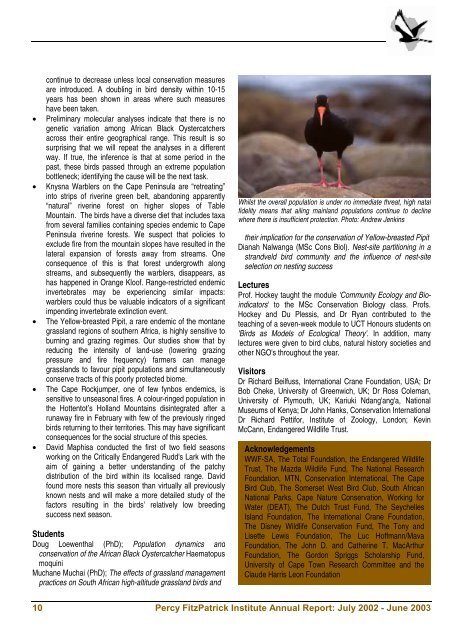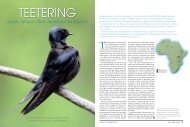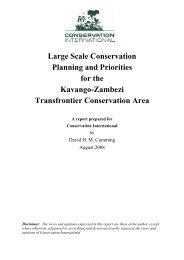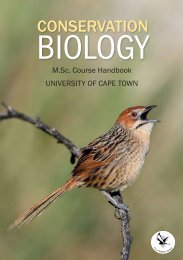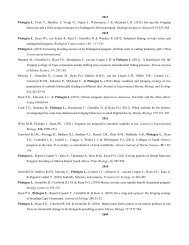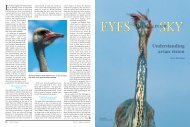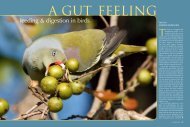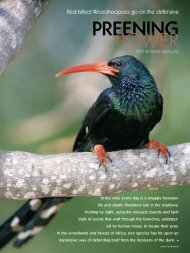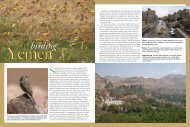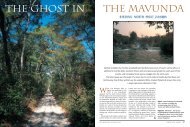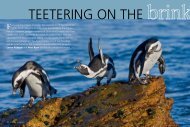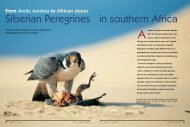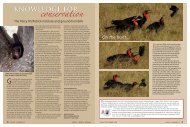Index of /depts/fitzpatrick/docs - Percy FitzPatrick Institute of African ...
Index of /depts/fitzpatrick/docs - Percy FitzPatrick Institute of African ...
Index of /depts/fitzpatrick/docs - Percy FitzPatrick Institute of African ...
You also want an ePaper? Increase the reach of your titles
YUMPU automatically turns print PDFs into web optimized ePapers that Google loves.
continue to decrease unless local conservation measuresare introduced. A doubling in bird density within 10-15years has been shown in areas where such measureshave been taken.• Preliminary molecular analyses indicate that there is nogenetic variation among <strong>African</strong> Black Oystercatchersacross their entire geographical range. This result is sosurprising that we will repeat the analyses in a differentway. If true, the inference is that at some period in thepast, these birds passed through an extreme populationbottleneck; identifying the cause will be the next task.• Knysna Warblers on the Cape Peninsula are “retreating”into strips <strong>of</strong> riverine green belt, abandoning apparently“natural” riverine forest on higher slopes <strong>of</strong> TableMountain. The birds have a diverse diet that includes taxafrom several families containing species endemic to CapePeninsula riverine forests. We suspect that policies toexclude fire from the mountain slopes have resulted in thelateral expansion <strong>of</strong> forests away from streams. Oneconsequence <strong>of</strong> this is that forest undergrowth alongstreams, and subsequently the warblers, disappears, ashas happened in Orange Klo<strong>of</strong>. Range-restricted endemicinvertebrates may be experiencing similar impacts:warblers could thus be valuable indicators <strong>of</strong> a significantimpending invertebrate extinction event.• The Yellow-breasted Pipit, a rare endemic <strong>of</strong> the montanegrassland regions <strong>of</strong> southern Africa, is highly sensitive toburning and grazing regimes. Our studies show that byreducing the intensity <strong>of</strong> land-use (lowering grazingpressure and fire frequency) farmers can managegrasslands to favour pipit populations and simultaneouslyconserve tracts <strong>of</strong> this poorly protected biome.• The Cape Rockjumper, one <strong>of</strong> few fynbos endemics, issensitive to unseasonal fires. A colour-ringed population inthe Hottentot’s Holland Mountains disintegrated after arunaway fire in February with few <strong>of</strong> the previously ringedbirds returning to their territories. This may have significantconsequences for the social structure <strong>of</strong> this species.• David Maphisa conducted the first <strong>of</strong> two field seasonsworking on the Critically Endangered Rudd's Lark with theaim <strong>of</strong> gaining a better understanding <strong>of</strong> the patchydistribution <strong>of</strong> the bird within its localised range. Davidfound more nests this season than virtually all previouslyknown nests and will make a more detailed study <strong>of</strong> thefactors resulting in the birds’ relatively low breedingsuccess next season.StudentsDoug Loewenthal (PhD); Population dynamics andconservation <strong>of</strong> the <strong>African</strong> Black Oystercatcher HaematopusmoquiniMuchane Muchai (PhD); The effects <strong>of</strong> grassland managementpractices on South <strong>African</strong> high-altitude grassland birds andWhilst the overall population is under no immediate threat, high natalfidelity means that ailing mainland populations continue to declinewhere there is insufficient protection. Photo: Andrew Jenkinstheir implication for the conservation <strong>of</strong> Yellow-breasted PipitDianah Nalwanga (MSc Cons Biol). Nest-site partitioning in astrandveld bird community and the influence <strong>of</strong> nest-siteselection on nesting successLecturesPr<strong>of</strong>. Hockey taught the module 'Community Ecology and Bioindicators'to the MSc Conservation Biology class. Pr<strong>of</strong>s.Hockey and Du Plessis, and Dr Ryan contributed to theteaching <strong>of</strong> a seven-week module to UCT Honours students on'Birds as Models <strong>of</strong> Ecological Theory'. In addition, manylectures were given to bird clubs, natural history societies andother NGO's throughout the year.VisitorsDr Richard Beilfuss, International Crane Foundation, USA; DrBob Cheke, University <strong>of</strong> Greenwich, UK; Dr Ross Coleman,University <strong>of</strong> Plymouth, UK; Kariuki Ndang'ang'a, NationalMuseums <strong>of</strong> Kenya; Dr John Hanks, Conservation InternationalDr Richard Pettifor, <strong>Institute</strong> <strong>of</strong> Zoology, London; KevinMcCann, Endangered Wildlife Trust.AcknowledgementsWWF-SA, The Total Foundation, the Endangered WildlifeTrust, The Mazda Wildlife Fund, The National ResearchFoundation, MTN, Conservation International, The CapeBird Club, The Somerset West Bird Club, South <strong>African</strong>National Parks, Cape Nature Conservation, Working forWater (DEAT), The Dutch Trust Fund, The SeychellesIsland Foundation, The International Crane Foundation,The Disney Wildlife Conservation Fund, The Tony andLisette Lewis Foundation, The Luc H<strong>of</strong>fmann/MavaFoundation, The John D. and Catherine T. MacArthurFoundation, The Gordon Spriggs Scholarship Fund,University <strong>of</strong> Cape Town Research Committee and theClaude Harris Leon Foundation10 <strong>Percy</strong> <strong>FitzPatrick</strong> <strong>Institute</strong> Annual Report: July 2002 - June 2003


